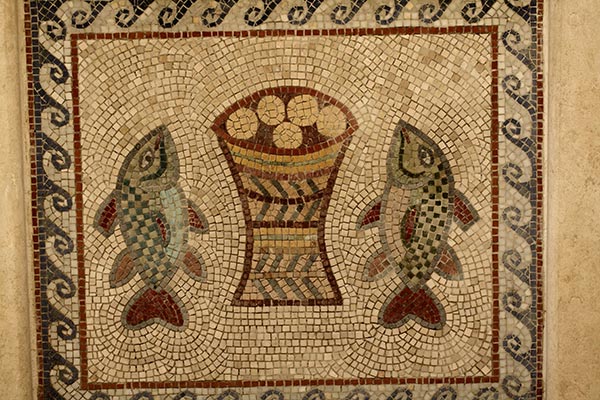Guest
Guest
 |  Subject: Archaeologists unearth extraordinary mosaic showing what might be Jesus feeding the 5,000 with five loaves Subject: Archaeologists unearth extraordinary mosaic showing what might be Jesus feeding the 5,000 with five loaves  Wed Sep 23, 2020 5:18 pm Wed Sep 23, 2020 5:18 pm | |
| https://www.naturalnews.com/2020-09-22-archaeologists-unearth-mosaic-showing-jesus-feeding-5000.html Bible stories come to life: Archaeologists unearth extraordinary mosaic showing what might be Jesus feeding the 5,000 with five loavesTuesday, September 22, 2020 by: Michael Alexander
(Natural News) A mosaic said to depict one of the Bible’s most enduring stories has been uncovered in the Holy Land.
The mosaic, which dates back 1,500 years and is said to depict the Feeding of the Multitude, was found by a team of archaeologists from the University of Haifa among the ruins of the ancient city of Hippos, which overlooked the famed Sea of Galilee.
According to the team, the mosaic, which shows elements pertaining to the miracle otherwise known as the Multiplication of Loaves and Fishes, once adorned a church built in the late fifth or early sixth century.
This structure, unfortunately, was burned to the ground during a raid by the invading Sasanian empire at the beginning of the seventh century — an incident that led to it becoming known by another name: The Burnt Church.
But the researchers believe that this unfortunate event was what saved the mosaic from falling into ruin, noting that the fire caused the church’s roof to collapse on top of it, eventually covering the mosaic with a protective layer of ash.
A mosaic filled with references to the Multiplication of Loaves and Fish
The mosaic, as described by the archaeologists, was crafted from brightly-colored tiles and had two Greek inscriptions that described the church as a “martyrion,” or a house of prayer originally built for a martyr named Theodoros.
In addition, the mosaic was covered in geometric patterns depicting birds, fruits and baskets, some of which were filled with loaves of bread and fish — likely a reference to the story of Jesus multiplying five loaves of bread and two fish in order to feed 5,000 men. (Related: Scientists uncover “invisible” ancient Hebrew inscription that can only be seen with advanced technology.)
Cementing the mosaic’s link to the story, the archaeologists said, was its depiction of 12 baskets filled with both bread and fish, which, according to scripture, were what the disciples were left with after Jesus fed the hungry.
Community who created the mosaic likely to be familiar with the original miracle
According to the archaeologists, the perfectly-preserved piece was part of a series of mosaics that adorned the church, with this particular one essentially functioning as a decorative “carpet.”
“Looking down, they must have thought of the miracles and works of Jesus around the lake just below,” said Michael Eisenberg, co-director of the Hippos-Sussita excavation.
The miracle, which was first mentioned in the Gospel of Saint John, is believed to have taken place north of Hippos.
“There is no doubt that the local community was well familiar with the two miracles of Feeding the Multitude and perhaps knew their estimated locations better than us,” Eisenberg said, adding that whoever commissioned the mosaic must have done so in order to establish an affinity of sorts to the miracle.
Eisenberg noted, however, that the mosaic does have some differences from the source material, the most notable being the number of fish in some of the baskets.
According to Eisenberg, this is important, given that depictions of fish have many symbolic meanings in the Christian tradition.
Aside from the mosaic, the excavation at the Burnt Church has also unearthed several other relics, such as burnt doors and bronze door knockers shaped like roaring lions.
How important is the city of Hippos?
Located in the heart of the Holy Land, Hippos, according to the late archaeologist Vassilios Tzaferis, was one of the most important cities in the East during the Roman-Byzantine period and was a part of the famous Decapolis, or League of Ten Cities.
Tzaferis, an expert in monks and monasteries in the Byzantine period, has since described the city as the most significant archaeological site on the eastern bank of the Sea of Galilee.
According to historical records, Hippos can be traced back to the Hellenistic period when it was first built as a fortified city in 200 BC .
By 80 BC, however, Hippos found itself conquered by the Hasmonean king Alexander Jannaeus, who then converted its citizens to Judaism.
Two decades later, the city fell to the Romans. As a sign of goodwill, the city was given back to King Herod as a gift from Augustus Caesar.
In 600 AD, the city was conquered by the Arab population. As noted by historians, while the citizens themselves were left relatively unharmed, the city was left to its own devices and allowed to fall into decline.
The city ultimately just languished before it fell victim to a powerful earthquake that led to its near-total abandonment.
Read more about the latest archaeological findings at Artifacts.news.
Sources include:
DailyMail.co.uk
Israel21C.org
LiveScience.com
Haaretz.com
TheTimesOfIsrael.com |
|





